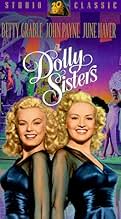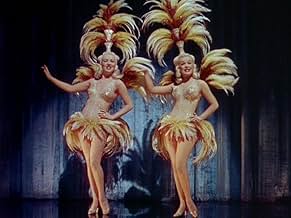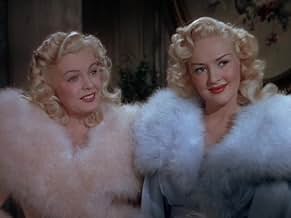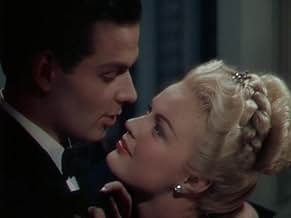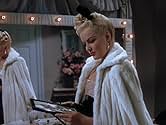IMDb-BEWERTUNG
6,2/10
883
IHRE BEWERTUNG
Füge eine Handlung in deiner Sprache hinzuTwo sisters from Hungary become famous entertainers in the early 1900s. Fictionalized biography with lots of songs.Two sisters from Hungary become famous entertainers in the early 1900s. Fictionalized biography with lots of songs.Two sisters from Hungary become famous entertainers in the early 1900s. Fictionalized biography with lots of songs.
- Regie
- Drehbuch
- Hauptbesetzung
- Für 1 Oscar nominiert
- 1 Nominierung insgesamt
Fred Aldrich
- Soldier
- (Nicht genannt)
Lester Allen
- Morrie Keno
- (Nicht genannt)
Herbert Ashley
- Fields
- (Nicht genannt)
Nino Bellini
- French Actor
- (Nicht genannt)
Brooks Benedict
- Party Guest
- (Nicht genannt)
Trude Berliner
- German Actress
- (Nicht genannt)
Edward Biby
- Party Guest
- (Nicht genannt)
Lulu Mae Bohrman
- Party Guest
- (Nicht genannt)
Eddie Borden
- Man on Bus
- (Nicht genannt)
Empfohlene Bewertungen
Betty Grable was considered quite the hot number in her day-a favorite pin-up girl of American soldiers. I always thought she had a crabby look on her face. Be that as it may, this is one of her biggest hits, probably her most lavish musical, made at the peak of her career. An up-and-coming June Haver also stars. Although it has some basis in the lives of the real Dolly sisters, the film makes no effort to be biographical. It traces the rise and heartbreak of the sisters as they conquer vaudeville, Broadway, and Europe singing tunes like "Carolina in the Morning," "Give Me the Moonlight, Give Me the Girl (and leave the rest to Me)," "I'm Always Chasing Rainbows," and the newer tune "I Can't Begin To Tell You," which was a Hit Parade favorite. If you watch a copy that hasn't been cut, the outrageous production numbers are considered the height of kitsch today, "monuments to bad taste" they have been called, that must be seen to be believed. "Darktown Strutters Ball" features Grable and Haver in with bronzed faces, singing in mutilated French, and cavorting around a Harlem set as pig-tailed 'picaninnies' surrounded by deeply tanned chorus girls in hats made of watermelons, dice, and playing cards. At least the girls are made up to look gorgeous and not foolish. It's quite a spectacle. ---from Musicals on the Silver Screen, American Library Association, 2013
Essentially a more lavish Technicolor remake of the 1940 B&W film "Tin Pan Alley", including two of the stars of the original: John Payne and Betty Grable. Both films have their relative pluses and minuses. I enjoyed the many outlandish costumes of the female stars and of the various extras, a common feature of many 1940s musicals. Grable and June Haver are much more of a sister act than Alice Faye and Grable were in the original, when they mostly performed their own numbers. The troubled on again off again romances, which fill in between musical shows, get awfully tedious, more so than in the original. If Alice Faye had taken Haver's part, as originally planned, it would have been interesting to see if she were again cast as the dominant sister(I doubt it). To me, Faye has more charisma than Haver, but the later makes a more look alike sister for Grable. I really missed Jack Oakie in this one. Frank Latimore was simply not an adequate substitute for Oakie's cheerful comic relief from Payne's serious demeanor. Payne's character is much more of a heel than in the original. That poor foxy woman he led on to believe he cared more for than Grable, left alone in the audience in the final scene, when he was reunited with Grable on the stage!
I was 8 years old when I first saw this movie in 1945. I was so impressed with the blond beauty of both girls and to know that the Dolly Sisters were real people. June Haver and Betty Grable really looked alike. In my childs mind I thought they were my private dancers and I wanted to be just like them. I actually thought I was the only one who knew about them and they were my secret......What a kid! Thanks for listening. Florence Forrester-Stockton
The real Dolly Sisters were dark, in both complexion and hair, Hungarian dancers with complex personalities and troubled lives, in fact Jenny had committed suicide several years before the debut of this musical, so if you are looking for anything resembling a depiction of the actual Dolly Sisters story look elsewhere. However if a sumptuous overstuffed showcase for blonds Betty Grable and June Haver is what you seek this is for you. Filmed in almost blinding Technicolor with some good songs and one great and beautiful one, I'm Always Chasing Rainbows, eye popping costumes and hairstyles this is old fashioned entertainment dished up with style.
The real-life Dolly sisters were brunettes but that didn't stop Fox from pairing Bette Grable and June Haver as the famous duo, in addition to fictionalizing their rise to fame in vaudeville and the legit circuit. Nevertheless, this is a typical 1940s charmer of a musical, with the talented John Payne for added appeal and good performances by S. Z. Sakall and Reginald Gardiner. Grable and Haver are seen in a good number of singing and dancing routines and there is even one new song ("I Can't Begin To Tell You") supposedly penned by John Payne. It's all very likeable technicolored entertainment in lavish style. Betty's role is a little more dramatic than usual and she does a good piece of emoting in the final scenes. If you're a Grable fan, you can't afford to miss this one! And she was never better than when she was teamed opposite John Payne--good chemistry and believable sparks.
Wusstest du schon
- WissenswertesIn one of the early songs, the lyrics mention the foxtrot. This dance was named after Harry Fox, a Vaudeville star credited with inventing the dance.
- VerbindungenFeatured in Gotta Dance, Gotta Sing (1982)
Top-Auswahl
Melde dich zum Bewerten an und greife auf die Watchlist für personalisierte Empfehlungen zu.
- How long is The Dolly Sisters?Powered by Alexa
Details
- Erscheinungsdatum
- Herkunftsland
- Sprache
- Auch bekannt als
- The Dolly Sisters
- Drehorte
- Produktionsfirma
- Weitere beteiligte Unternehmen bei IMDbPro anzeigen
Box Office
- Budget
- 2.510.000 $ (geschätzt)
- Laufzeit1 Stunde 54 Minuten
- Seitenverhältnis
- 1.37 : 1
Zu dieser Seite beitragen
Bearbeitung vorschlagen oder fehlenden Inhalt hinzufügen



